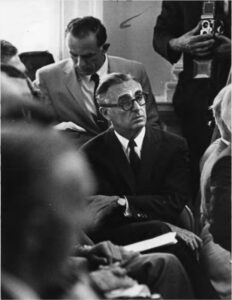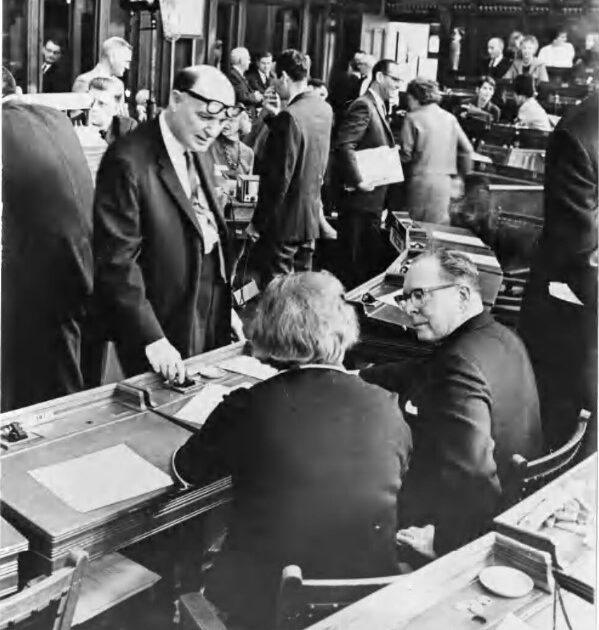By Misa Giroux

Senator Abraham Ribicoff at Connecticut Constitutional Convention, Hartford, July 1965 – By Ellery G. Kington, Hartford Times, Hartford History Center, Hartford Public Library. In Copyright, non-commercial use permitted.
Only the second constitution in the state’s history, Connecticut currently operates under the Connecticut Constitution of 1965. Before 1965, the state had functioned under the Constitution of 1818 for 147 years. Among other changes, the Constitution of 1965 transformed Connecticut’s representation model by replacing equal town allotments with a system based on population, ensuring a more equitable distribution of political power.
Earlier Governing Documents
Prior to 1965, Connecticut was governed under three key documents: the Fundamental Orders (1639), the 1662 Royal Charter, and the 1818 Constitution. The Fundamental Orders established a system in which each town had equal representation in the legislature, prioritizing political equality for towns rather than individuals. This system of town-based representation persisted through 1965, even as population shifts created significant disparities in political power.
The Need for a New Constitution
While the issue of equal representation was debated during Connecticut’s 1818 Constitutional Convention, no major changes were made to the system. Newly incorporated towns continued to receive the same legislative representation as established towns, despite the growing populations of urban areas. In the 1960s, a series of landmark US Supreme Court rulings reinforced the principle of “one person, one vote,” first established by the 14th Amendment’s Equal Protection Clause, requiring legislative districts to be based on population.
These rulings set the stage for reform in Connecticut. Along with other residents, political activists Miriam “Mims” and Oliver Butterworth of West Hartford and the League of Women Voters filed a lawsuit, Butterworth v. Dempsey, against the state in 1964, arguing that the state’s representation system violated the US Constitution. The US Supreme Court, enforced through the United States District Court for the District of Connecticut, ruled in their favor and required Connecticut to amend or revise its form of legislative representation. The necessity of calling a convention, rather than utilizing the standard constitutional amendment process, arose because the federal court had cast “grave doubt” on the power of the malapportioned House to initiate a constitutional amendment to fix its own unconstitutional structure. As a result, the convention was convened by virtue of Public Act No. 1 of the November Special Session of 1964 of the General Assembly, effective in January 1965.
Drafting a New State Constitution

Politicians Raymond E. Baldwin, Governor John Dempsey, and Hartford Mayor William Glynn with souvenir flags at the Constitutional Convention in Hartford in July 1965 – By Einar G. Chindmark, Hartford Times, Hartford History Center, Hartford Public Library. In copyright, non-commercial use permitted.
Eighty-four delegates, including former governors, judges, legislators and mayors, split evenly between Democrats and Republicans, were nominated by their respective parties and were all elected as uncontested winners in a special election. Delegates convened from July through October 1965 to draft a new constitution with the primary goal of legislative reapportionment.
To ensure bipartisan cooperation, the convention adopted a set of rules governing its operation, most importantly Rule 55, which required a vote of two-thirds of all members (rather than just a simple majority) for the adoption of any motion or resolution. This rule made passing significant changes challenging and many proposals were rejected—including those supporting a unicameral legislature, lowering the voting age (then 21), and establishing a Commission or Office of the Arts—often before being taken up by the full convention.
After four months of plenary sessions, committee meetings, and public hearings, the new constitution was approved by a 2-1 margin in a statewide referendum on December 14, 1965. Achieving the convention’s goals, the new constitution greatly increased representation for cities, especially Bridgeport, New Haven, and Hartford, whose delegations expanded from two to ten members each. In the very first election under the new system, six African Americans were elected to the House, and Boce W. Barlow, Jr. became the state’s first Black senator.
While the shift to population-based representation was one of the most significant changes in the 1965 Connecticut Constitution, it was not the only reform enacted. The new constitution also expanded religious freedom for non-Christians, established a right to free public education, and provided mechanisms for future amendments and constitutional conventions.
The overhaul of legislative representation, however, was among the most impactful. It directly addressed longstanding inequalities and brought Connecticut in line with the “one person, one vote” principle upheld by the US Supreme Court. The new constitution played a crucial role in fostering greater political inclusion and ensuring a legislative body that more accurately reflected the state’s population. Governor John N. Dempsey officially proclaimed the Constitution of the State of Connecticut adopted on December 30, 1965.
Misa Giroux is the digital humanities education manager at CT Humanities.









